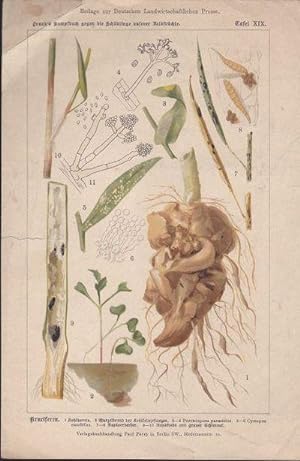Beschreibung
Berlin, Germany: Paul Parey Buchhandling Publishing House. Good with no dust jacket. 1915. N/A. Supplement to the German Agricultural Presses. Written in German. Plate XIX Kruciferen. Peronospora Parasitsica, Cystopus candidus and others. I cannot read some of the titles as they are written in old German script. "Kruciferen (Brassicaceae) , dicotyledonous plant family of the order of Krucifloren, annual, biennial or perennial herbs, sometimes semishrubs: with a taproot, which is thickened in some r√ ¬ľbenartig, round or square stems and simple nebenblattlosen leaves, either all applicants with a rosette are united, or even on the stem are alternate and entire, toothed, pinnatifid, lyre-shaped, even several times pinnate, usually below stalked, often upwards are sitting with heart or arrow-shaped base. Die Bl√ ¬ľten stehen in Trauben, welche bald verl√ ¬§ngert, bald verk√ ¬ľrzt und dann doldentraubig erscheinen und immer auf den Enden des Stengels und der √ ¬ ste sich befinden, bisweilen durch den unter ihnen stehenden Seitenzweig zur Seite gedr√ ¬§ngt werden und dann dem Blatt gegen√ ¬ľberzustehen scheinen. The flowers are in clusters, which are sometimes extended, sometimes shortened and then appear doldentraubig and always on the ends of the stem and the branches are located, sometimes by having them standing side-branch pushed to the side and then confront the leaf appear. Den Trauben fehlen meistens die Deckbl√ ¬§tter unter den Bl√ ¬ľtenstielchen. The grapes usually lack the bracts under the flower stalk. Die regelm√ ¬§√ ¬ igen Bl√ ¬ľten haben vier freie, abfallende Kelchbl√ ¬§tter, von denen zwei rechts und links und etwas tiefer, die beiden andern vorn und hinten stehen; jene sind an der Basis oft mehr oder weniger sackf√ ¬ rmig nach unten aufgetrieben. The regular flowers have four free, falling petals, two of them left and right and a little deeper, the other two are the front and rear, are those at the base often more or less distended sac down. Die vier Blumenbl√ ¬§tter stehen kreuzweise zwischen den Kelchbl√ ¬§ttern auf dem Bl√ ¬ľtenboden eingef√ ¬ľgt; sie sind meist lang genagelt und haben eine ungeteilte oder ausgerandete, seltener gespaltene, noch seltener fiederteilige Platte von wei√ ¬ er oder violetter oder gelber Farbe. The four petals crosswise between the sepals are inserted on the receptacle, they are nailed usually long and have an undivided ausgerandete or, less often bifid, even more rarely fiederteilig slab of white or purple or yellow. Von den sechs auf dem Bl√ ¬ľtenboden entspringenden, meist freien Staubgef√ ¬§√ ¬ en stehen zwei kleinere den beiden seitlichen Kelchbl√ ¬§ttern gegen√ ¬ľber, die andern paarweise vor dem vordern und hintern Kelchblatt. Of the six blossoms springing on the ground, usually free stamens, two smaller on the two lateral sepals are facing, the other in pairs in front of the anterior and posterior sepal. Auf dem Bl√ ¬ľtenboden befinden sich au√ ¬ erdem nektarabsondernde Dr√ ¬ľsenh√ ¬ cker an der Basis der Kelch- und Blumenbl√ ¬§tter. On the base of the flower are also cusp nektarabsondernde glands at the base of sepals and petals. Das oberst√ ¬§ndige einfache Pistill wird aus zwei rechts und links stehenden Karpellen gebildet, welche zu einem zweif√ ¬§cherigen Fruchtknoten mit einfachem, endst√ ¬§ndigem Griffel und zwei meist zusammenh√ ¬§ngenden Narben vereinigt sind. The oberst√ ¬§ndige simple pistil is composed of two right and left are carpels, which one zweif√ ¬§cherigen ovary with a single, terminal pistil and two mostly contiguous scars are united. Die Scheidewand im Fruchtknoten ist daher von vorn nach hinten gerichtet; an ihrem Rand, The septum in the ovary is therefore directed from front to back, on its edge, "- retro bib. CONDITION: Dust soiling. A 1 inch tear to left edge 4 1/2 inches from top edge. Creasing top corner 6 by 9 Inches. Print. ; Print . whbx 6E. Bestandsnummer des Verkšufers 049362
Verkšufer kontaktieren
Diesen Artikel melden
![]()
